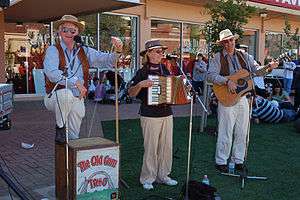Bush band
A bush band is a group of musicians that play Australian bush ballads. A similar bush band tradition is also found in New Zealand.

Instruments
In addition to vocals, instruments featured in bush bands may include fiddle, accordion, guitar, banjo, mandolin, concertina, harmonica, lagerphone, bush bass (tea chest bass) or double bass, tin whistle, and bodhrán. Less common are the piano, bones, barcoo dog (a sheep herding tool used as a sistrum), spoons, and musical saw. Although not traditional, electric bass guitar or electric guitar have occasionally been used since the 1970s.
Repertoire and function
Bush bands play music for bush dances, in which the dance program is usually based on dances known to have been danced in Australia from colonial times to the folk revival in the 1950s. Contemporary dances, set in the traditional style, are also featured at bush dances.
Some popular traditional bush dances are Stockyards, Haymaker's Jig, Galopede, Brown Jug Polka, Virginia Reel and barn dance. Popular contemporary bush dances include Blackwattle Reel, Jubilee Jig, CHOGM Pentrille, Knocking Down His Cheque and Midnight Schottische.
Bush bands also play bush ballads, many of which date to the 19th century. Among the most notable bush lyricists was the poet Banjo Paterson (1864–1941).
The Bush Music Club, based in Sydney, New South Wales, Australia, hold regular bush dances and Colonial Balls where bush bands perform.[1]
Origin
Bush bands, as currently formulated, experienced a revival in 1953 with the musical play Reedy River, which was first produced and published by the New Theatre (Sydney)[2] and most recently produced in 2002. Written by Dick Diamond, the musical featured twelve or so Australian songs, which included Doreen Jacobs' setting of Helen Palmer's "Ballad of 1891," as well as the title song, Chris Kempster's setting of Lawson's "Reedy River." The backing band for this popular stage production was "The Bushwhackers", who had formed a year earlier in 1952. As the musical was performed in Brisbane and other Australian cities, local "bush bands" modeled on the Sydney group, such as Brisbane's "The Moreton Bay Bushwhackers," sprang up in each place; many of these remained together following the closing of the musical, and spawned other, similar groups.
Contemporary bush bands
Perhaps the best known bush band internationally, albeit in their later years with the influence of English folk rock bands like Fairport Convention and Steeleye Span, was the Bushwackers (spelt without the "h" as in the earlier Bushwhackers Band of the 1950s), who formed in Melbourne and were active from the early 1970s to 1984. The "Wackers," as they are known by their fans, toured around the world and with their larrikin, outgoing style, song books, dance instruction books and records, contributed markedly to the spread of bush music and dancing, especially in Australia. Their style was infused with Celtic music (i.e. reels and jigs) to a greater extent than previous bush bands, and they used an electric bass guitar in place of the more traditional bush bass. The period leading up to and following Australia's Bicentenary, 1988, saw a marked resurgence in bush music and bush dances that lasted for many years.
Many bands also bearing the rock influence and adding original music rode this Australiana wave. Examples are the Ants Bush Band, Eureka!, Skewiff, Rantan Bush Band and Bullamakanka and some bands, including the Bushwackers, still perform on an occasional basis.
In recent years the emergence of bands such as The Currency (Melbourne), The Handsome Young Strangers (Sydney) Jack Flash (South Queensland)[3] and Sydney City Trash (Sydney) has moved bush music into rock and roll venues and major festival stages, with a blended style that includes rock drums and guitars whilst combining with Celtic influences. The Handsome Young Strangers lean more towards the traditional style of bands such as The Bushwackers, whilst The Currency, Jack Flash and Sydney City Trash incorporate both punk and Celtic styles.
List of notable bush bands
Australia
- The Bushwackers Established 1971 [4](Melbourne, Victoria)
- Mucky Duck Bush Band Established 1974 [5] (Perth, Western Australia)
- Franklyn B Paverty Established 1970 [6](Canberra and the region around the Australian Capital Territory)
- The Cobbers Bush Band Established 1968 [7] [8] (Melbourne, Victoria)
- The Sundowners Established 1977 [9](Melbourne, Victoria)
New Zealand
- The Big Muffin Serious Band
- The Pioneer Pog 'n' Scroggin Bush Band
See also
- Australian folk music
- Bush dance
- Skiffle bands
- Warren Fahey, folklore collector and performer of Australian traditional music
Notes
- "Bush Music Club Inc. - Bushdances around Sydney". Bushmusic.org.au. Retrieved 2010-12-28.
- Reedy river [music] : the songs from the Australian musical drama / by Dick Diamond
- "Jack Flash". Triple J Unearthed. Retrieved 9 December 2019.
- The Bushwackers https://thebushwackers.com.au/about/. Retrieved 9 December 2019. Missing or empty
|title=(help) - Mucky Duck Bush Band https://www.muckyduckbushband.com/about-the-duck. Retrieved 9 December 2019. Missing or empty
|title=(help) - Paverty Bush Band http://paverty.com.au/. Retrieved 9 December 2019. Missing or empty
|title=(help) - BBC (UK) https://www.bbc.co.uk/music/artists/2c7c8077-fd3c-488b-abf8-3d52b7bc774c. Retrieved 9 December 2019. Missing or empty
|title=(help) - Cobbers Bush Band http://www.cobbersbushband.com/. Retrieved 9 December 2019. Missing or empty
|title=(help) - Australian Folk Music http://australianfolk.blogspot.com/2011/03/sundowners-classic-ballads-1981.html. Retrieved 9 December 2019. Missing or empty
|title=(help)
References
- Chris O'Connor & Suzette Watkins: Begged, Borrowed & Stolen, Talunga Music., 1979 ISBN 0-9594713-0-8
- David G Johnson: Bush Dance - A collection of Traditional Tunes, Bush Music Club., 1984 ISBN 0-9599528-1-0
- Max Klubal: Music for Australian Folk Dancing with Instructions, The Australian Folk Trust., 1979
- Jan Wositzky, Dobe Newton, Barry Olive: The Bushwackers Band Dance Book, Greenhouse Publications 1980 ISBN 0-909104-25-5
- David De Santi Australian Traditional Dance Tunes, Wongawilli Colonial Dance Tunes, 2002, ISMN M900951809